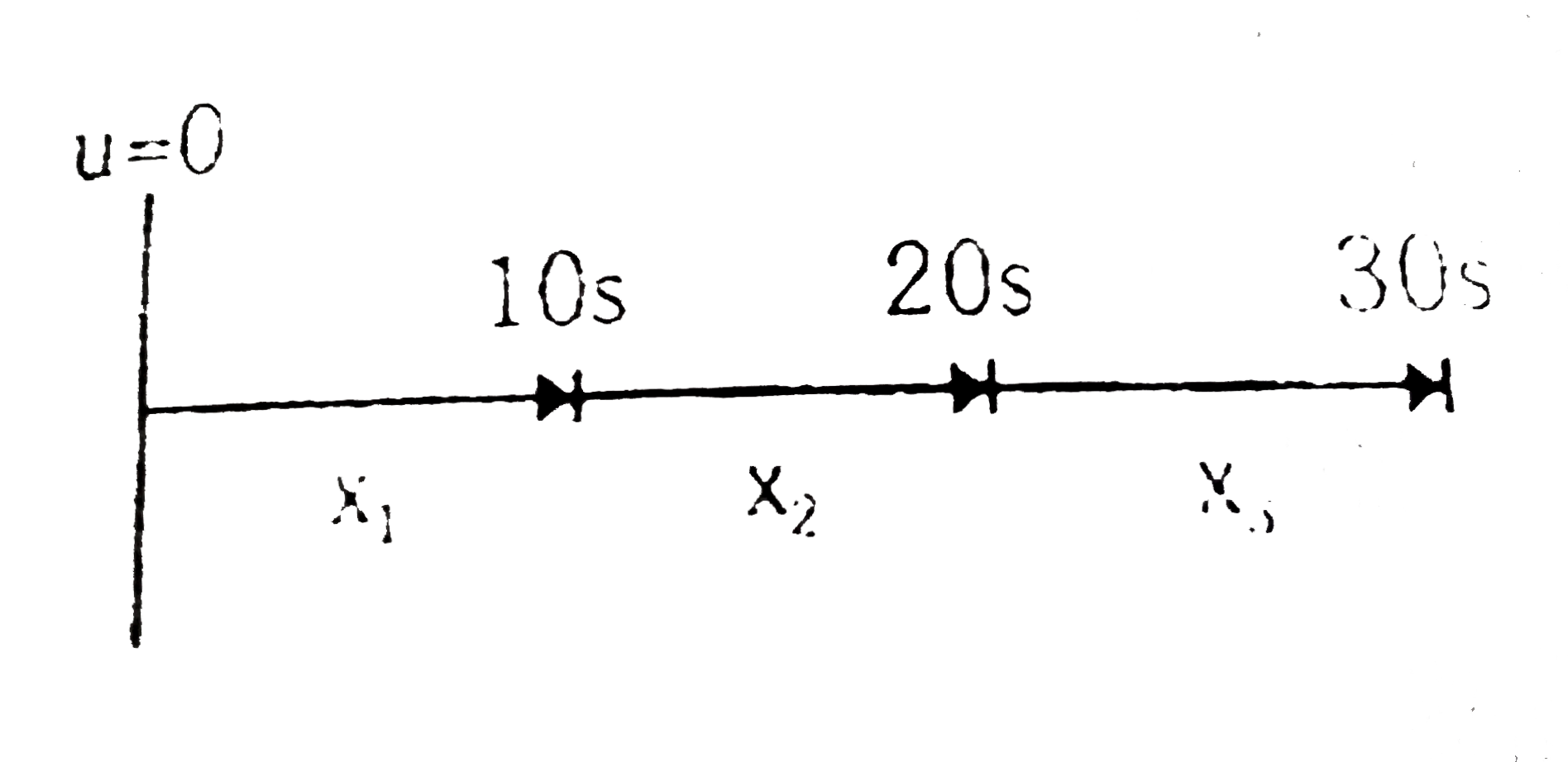A body starts from rest and is uniformly accelerated is 30m/s . The distance travelled in the first 10 s is x1, next 10 s is x2 and the last 10 s is x3. Then x1:x2:x3 is the same as :-Solution in Gujrati
1:2:3
1:2:5
1:3:5
1:4:9
The correct Answer is:C

x1=12a(10)2
x1+x2=12a(20)2
x1+x2+x3=12a(30)2⇒x1:x2:x3=1:3:5
Topper's Solved these Questions
- KINEMATICSBOOK - ALLEN CHAPTER - KINEMATICSEXERCISE - EXERCISE-02
57 Videos
- KINEMATICSBOOK - ALLEN CHAPTER - KINEMATICSEXERCISE - EXERCISE-03
6 Videos
- KINEMATICSBOOK - ALLEN CHAPTER - KINEMATICSEXERCISE - EXERCISE-2
89 Videos
- ERROR AND MEASUREMENTBOOK - ALLEN CHAPTER - ERROR AND MEASUREMENTEXERCISE - Part-2(Exercise-2)(B)
22 Videos
- KINEMATICS (MOTION ALONG A STRAIGHT LINE AND MOTION IN A PLANE)BOOK - ALLEN CHAPTER - KINEMATICS (MOTION ALONG A STRAIGHT LINE AND MOTION IN A PLANE)EXERCISE - BEGINNER S BOX-7
8 Videos
Similar Questions
A particle is moving in a plane with velocity given by →u=u0ˆi+(aωcosωt)ˆj, where ˆi and ˆj are unit vectors along x and y axes respectively. If particle is at the origin at t=0. Calculate the trajectory of the particle :-
View SolutionThe equation of one dimensional motion of the particle is described in column I. At t=0, particle is at origin and at rest. Match the column I with the statement in Column II.
Column IColumn II(A)x=(3t2+2)m(p)Velocity of particle at t=1s is 8m/s(B)v=8tm/s(q)Particle moves with uniform acceleration(C)a=16t(r)Particle moves with variable acceleration(D)v=6t−3t2(s)Particle will change its direction some time
View SolutionA student performs an experiment to determine how the range of a ball depends on the velocity with which it is projected. The "range" is the distance between the points where the ball lends and from where it was projected, assuming it lands at the same height from which it was projected. It each trial, the student uses the same baseball, and launches it at the same angle. Table shows the experimental results.
∣∣ ∣ ∣ ∣ ∣ ∣∣TrailLaunch speed(m/s)Range(m)110822031.833070.7440122.5∣∣ ∣ ∣ ∣ ∣ ∣∣
Based on this data, the student then hypothesizes that the range, R, depends on the initial speed v0 according to the following equation : R=Cvn0, where C is a constant and n is another constant.
Based on this data, the best guess for the value of n is :-
View SolutionA cube has a side of length 1.2×10−2m. Calculate its volume.
View SolutionA football player kicks a ball at an angle of 30∘ with an initial speed of 20 m/s. Assuming that the ball travels in a vertical plane, calculate (a) the time at which the ball reaches the highest point (b) the maximum height reached (c) the horizontal range of the ball (d) the time for which the ball is in the air, (g=10m/s2)
View SolutionThe number of integral solutions of x1+x2+x3+x4=30 such that 0≤xi≤10 is:
View SolutionThe number of integral solutions of x_(1)+x_(2)+x_(3)+x_(4)=30 such that 0<=x_(i)<10, is
View SolutionIf the mean and standard deviation of 10 observations x_(1),x_(2),......,x_(10) are 2 and 3 respectively,then the mean of (x_(1)+1)^(2),(x_(2)+1)^(2),....,(x_(10)+1)^(2) is equal to
View SolutionThree particles are projected upwards with initial speeds 10m/s,20m/s,30m/s. The displacements covered by them in their last second of motion are x1,x2,x3 then:
View SolutionA body starts from rest and is uniformly accelerated for 30 s. The distance travelled in the first 10 s is x1, next 10 s is x2 and the last 10 s is x3. Then x1:x2:x3 is the same as :-
View SolutionConsider the quantities such that x1,x2,….x10,−1≤x1,x2….,x10≤1 and x31+x32+…+x310=0, then the maximum value of x1+x2+….+x10 is
View Solutionयदि 10 प्राकृत संख्याओं x1,x2,x3,…………x10 का माध्य ¯¯¯X हो, तो प्रदर्शित करो कि :
(x1−¯¯¯X)+(x2−¯¯¯X)+…………..+(x10−¯¯¯X)=0
View SolutionThe mean and standard deviation of 10 observations x1,x2,x3…….x10 are ¯x and σrespectively. Let 10 is added to x1,x2…..x9and90 is substracted from x10. If still, the standard deviation is the same, then x10−¯x is equal to
View SolutionA body starts from rest and moves with constant acceleration for t s. It travels a distance x_(1) in first half of time and x_(2) in next half of time, then
View SolutionConsider the quantities such that x1,x2,….x10,−1≤x1,x2….,x10≤1 and x31+x32+…+x310=0, then the maximum value of x1+x2+….+x10 is
View Solution
